How I got my Minolta XG-E… In my Nikomat FT2 review, I mentioned my friend Mark who bestowed that camera upon me. Here’s the full story: One week I showed up to Mark’s office for his weekly Models and Movies night (that’s train models, you perv). I had my Pentax KX with me and mentioned that I was getting back into film photography. Mark beckoned me into his back room and beat me until I came to my senses. No, sorry, that’s what he should have done. What he really did was take his collection of 35mm SLRs, put them in a box and give them to me. Mark is an awesome guy and I’m lucky to have him as a friend. Send me $20 via PayPal and I’ll introduce you to him.
Among the gear he gifted to me was the mongrel Minolta XG-E shown here. As you can see, it’s pretty ragged, and this is after I cleaned it up a bit. The body is adorned with chips, scratches and cracks. The leatherette is attempting to peel itself off the camera, presumably so it can crawl under the porch to die. And all this with the camera having spent most of its life in a naugahyde case, which I won’t show you lest Mark get arrested for posthumous abuse of a nauga. When I first set eyes on the camera, I didn’t know whether to put film in it or take it to the veterinarian and have it euthanized.
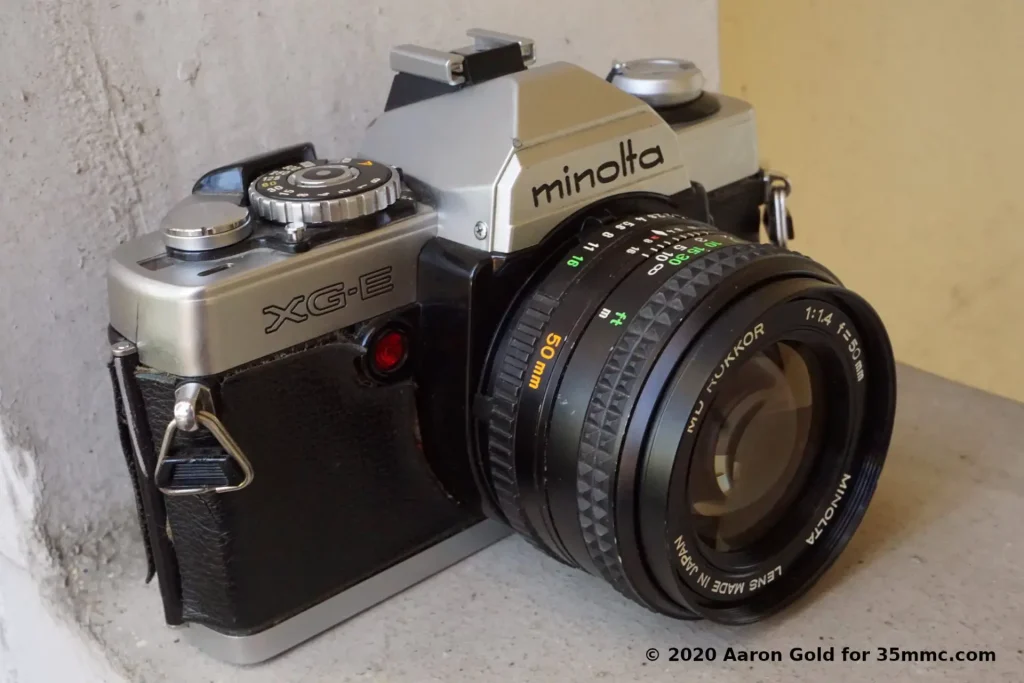
Mark assured me that the camera’s well-used appearance was well-earned: This XG-E was the camera he used most in his youth, and what he used it for was sports photography. “It was rode hard and put away wet,” he said, drawing on a seemingly bottomless well of clichés. “I beat it like a rented mule. Used it to hammer in a couple of nails.”
I figured the chances of this tattered and tired XG-E being in operable condition were roughly on par with a Nikon F6 owner singing the praises of a Ricoh KR-5, but when I popped in a pair of silver-oxide batteries, I was pleased to find that it worked just fine—the meter came on (in automatic mode, at least) and the shutter fired at all speeds. That’s more than I can say for the two Nikons of similar vintage that floated across my transom (an FG and an FE, both DOA).

As with the Nikomat FT2, Mark’s father bought this camera in Japan, which is why it’s called XG-E and not XG7 (its American name) or XG2 (Europe). According to The Rokkor Files—which, for those not familiar, is a gold mine of information about older Minoltas—the XG series was introduced in 1977 as Minolta’s entry-level SLR. (Here’s a cool XG7 commercial.)
As beaten up as it looked, the XG-E seemed to work pretty well. Mark gave it to me with a Minolta Rokkor 50mm f/1.4 lens, and the first roll of pictures I shot with it looked fantastic. They included the photo below, a grab shot of my friend Jason at Langer’s Deli in Los Angeles. This is one of my favorite pictures, and the XG-E captured it beautifully.

Only one thing about the XG-E puzzled me: When I turned the shutter-speed dial out of automatic mode, the meter would go dark. I figured something was wrong with the camera—given the way it looked, something had to be wrong with it—but I soon learned this is exactly the way the XG-E is supposed to work. This has to be one of the silliest design decisions I’ve ever seen, and as the owner of a Nikomat FT2, I know a thing or two about silly design decisions.
I have since learned Minolta XG-E (XG7, XG2—sorry to keep repeating that, but we must please the Google gods) was designed to compete with aperture-priority semi-automatics like the Nikon EM and Pentax ME. But while those cameras only offer three shutter-dial settings—automatic, flash sync and bulb—the XG-E has a full range of speeds from 1 second to 1/1000. Minolta’s way of making this effectively an automatic camera was to disable the meter when a manual shutter speed is selected.
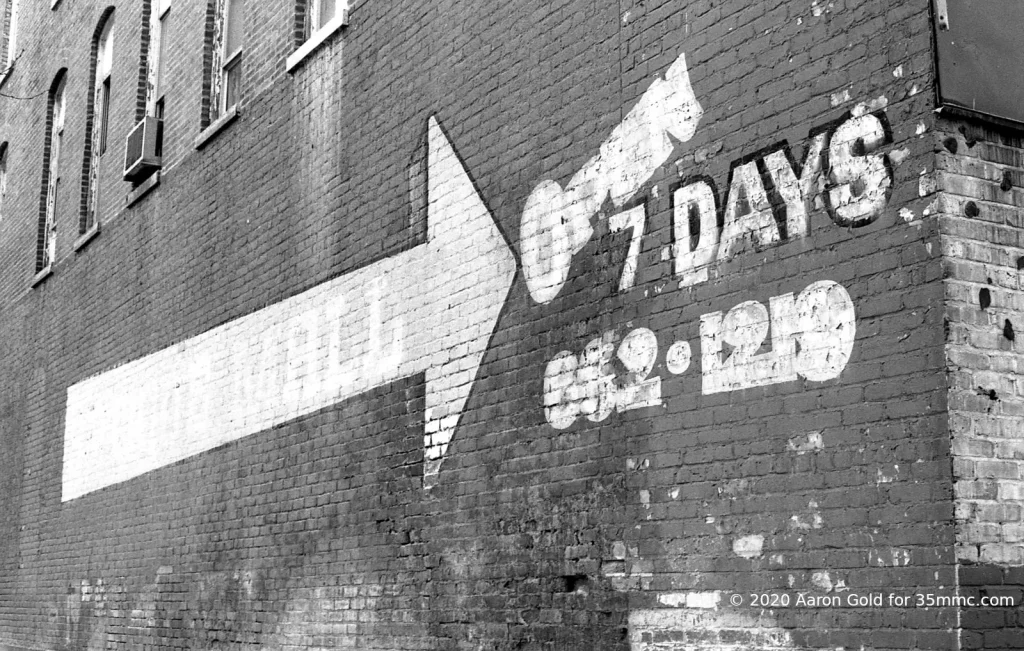
My uneducated guess is that the Minolta folks were trying to save money by sharing parts with the XD. All well and good, but I still can’t believe that a group of seemingly intelligent men (and they had to be men; it was the 1970s, and besides, no woman would suggest anything so asinine) got together in a conference room and convinced themselves this was a good idea. Only from the mind of Minolta, I guess.
The irony is that the XG-E has one of the best shutter-speed dials of any camera I own. It’s big, knurled, and easy to turn, and it’s positioned right at the front edge of the camera so you can turn it with a finger-tip while keeping a solid grip on the body.
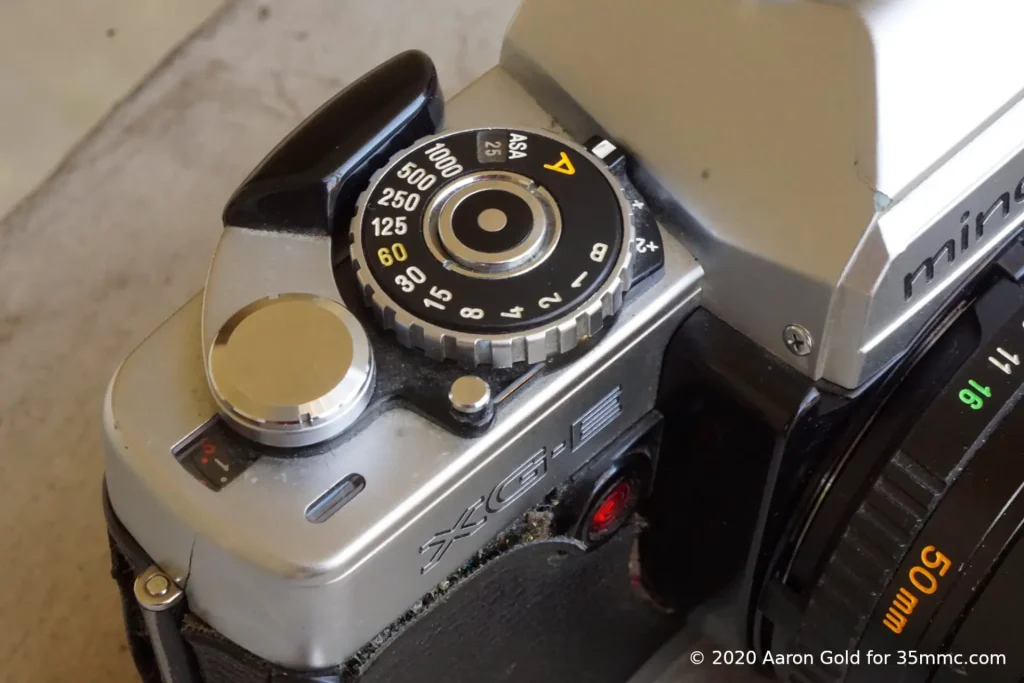
The meter is just as good. Inside the viewfinder is a scale of shutter speeds with LEDs that indicate which one is selected and red arrows that warn of over- or under-exposure. Cooler yet is the way you turn the meter on: Take it to dinner, tell it how beautiful it is, then nibble gently on its earlobe… no, seriously, all you do is place your finger on the shutter button. It’s touch-sensitive! How cool is that—and on a camera designed in the 1970s! I wish more of my cameras (I’m looking at you, Pentax MX) had such a great controls. And yet on the XG-E, they are little more than a tease.
Once you resign yourself to using it in automatic mode, the Minolta XG-E is a magnificent SLR. It’s smaller and lighter than a Pentax K-series, though not quite as diminutive as a Pentax M. With the Rokkor 50/1.4 fitted and no strap or film, it weighs in at a reasonable 1 lb 10.5 oz (751g). I find that the squared-off edges make for less-than-ideal ergonomics, but I like the XG-E’s substantial feel. The mechanism works with minimal vibration and has a short, if slightly stiff, winder pull. In keeping with its amateur-camera status, the XG-E lacks a depth-of-field preview and a mirror lock-up, but it does have an electronic self-timer.

But the most important aspect—to me, at least—is that the XG-E makes it easy to create really nice pictures. I’m a manual-camera snob, but the results I’ve had with the XG-E are so good that I find myself making excuses. After all, is aperture-priority really that much of a cheat? I still hae control of my pictures, determining the best exposure settings for the depth-of-field or motion blur I want—I’m just letting the camera set one of the dials, that’s all.
Nah, I don’t buy it either, but a guy’s gotta sleep at night.
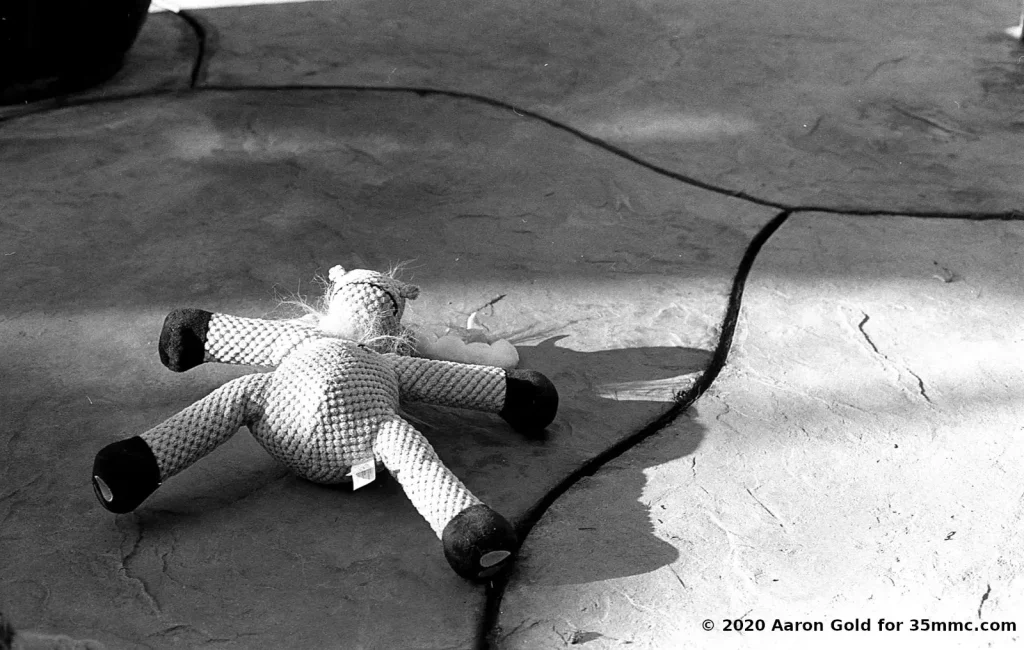
What I like best about this XG-E is that it’s the perfect beater cam. I can bring it on a boat trip or take it to a party and hand it around, and anyone sober enough to focus is bound to get good pictures. (If they aren’t sober enough to focus, that’s what f/22 is for.) And if the camera gets dinged up—well, look at it. How would I even know?
The XG-E has kindled an appreciation for Minolta cameras. This is clearly a well-designed instrument, one that has suffered years of abuse and neglect and not only works, but works well. Fiddle with its controls and you can tell you’re using a well-engineered, well-built camera. Look at the pics and you know you’re seeing the result of a good meter and high-quality optics. The XG-E makes me want to buy an XD-11 and more Rokkor lenses.

That might not be a good idea, because the XD-11 has a good reputation and doesn’t come cheap. But the XG-E (or XG2 or XG7 or whatever you want to call it) does—tested and working ones sell on the ‘Bay in the $25 to $50 range, significantly cheaper than auto-only Pentaxes (ME, MG, MV) and Nikons (EM, FG). Minolta’s manual-focus Rokkor MD-series lenses are also bargains compared to Pentax and Nikon. Clearly, the XG-E/2/7 is underrated and underappreciated.
Would I recommend the XG-E? I have trouble recommending any automatic-only (or, in this case, automatic-mostly) camera, at least to someone looking for a single SLR to do it all. I think manual shooting is a skill that all film photographers should have and hone. More so than with digital, manual exposure just goes with the territory. And isn’t the object of film photography to get the pictures we want, exactly the way we want them? I’m not opposed to automation, but in my snobbish opinion it’s a fine line between shooting in program mode and taking pictures with your iPhone.
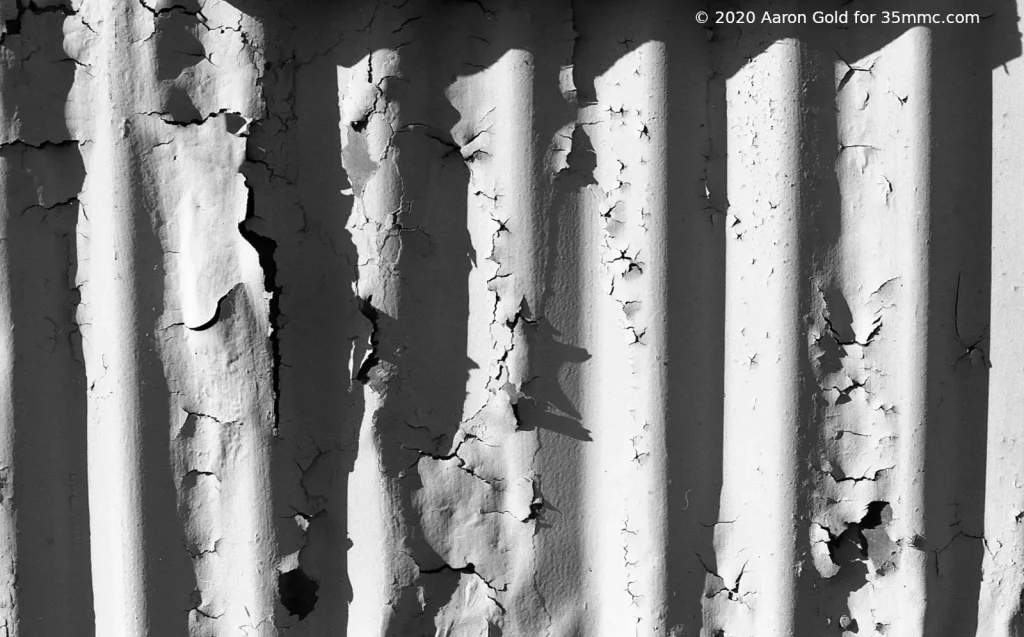
For someone looking for a good walk-around automatic SLR, yes, the XG-E (or XG2 or XG7 or whatever it’s called in your neck of the woods) is an outstanding camera. Mine looks like it fell out of a tree and hit every branch on the way down, and yet it still produces beautiful pictures.
The truth is I’ve got no good reason to use my Minolta XG-E. I’ve only got one lens for it and I prefer cameras that give me the option of shooting manually (with a working meter, thank-you-very-much).
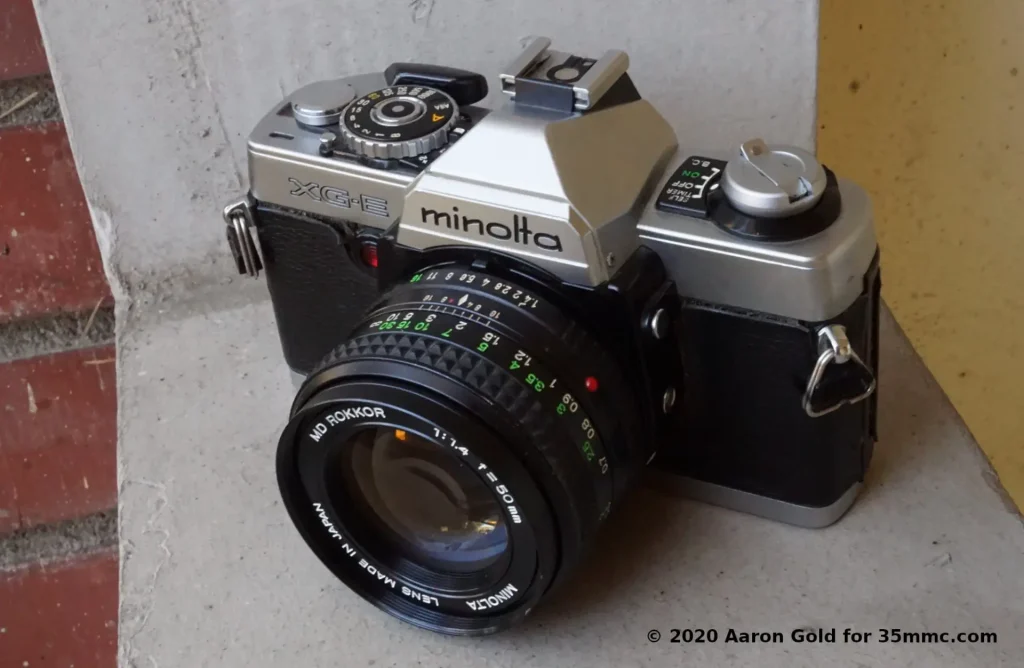
And yet I do use it—I use it often, and not just because I like it. I feel like have an obligation to take pictures with it. I think that if a camera can survive decades of abuse and still work flawlessly, it deserves to remain in front-line service. Take one look at my well-worn Minolta XG-E, and I think you’ll agree: It’s just begging to be taken out and shot.
© 2020 Aaron Gold for 35mmc.com
Share this post:
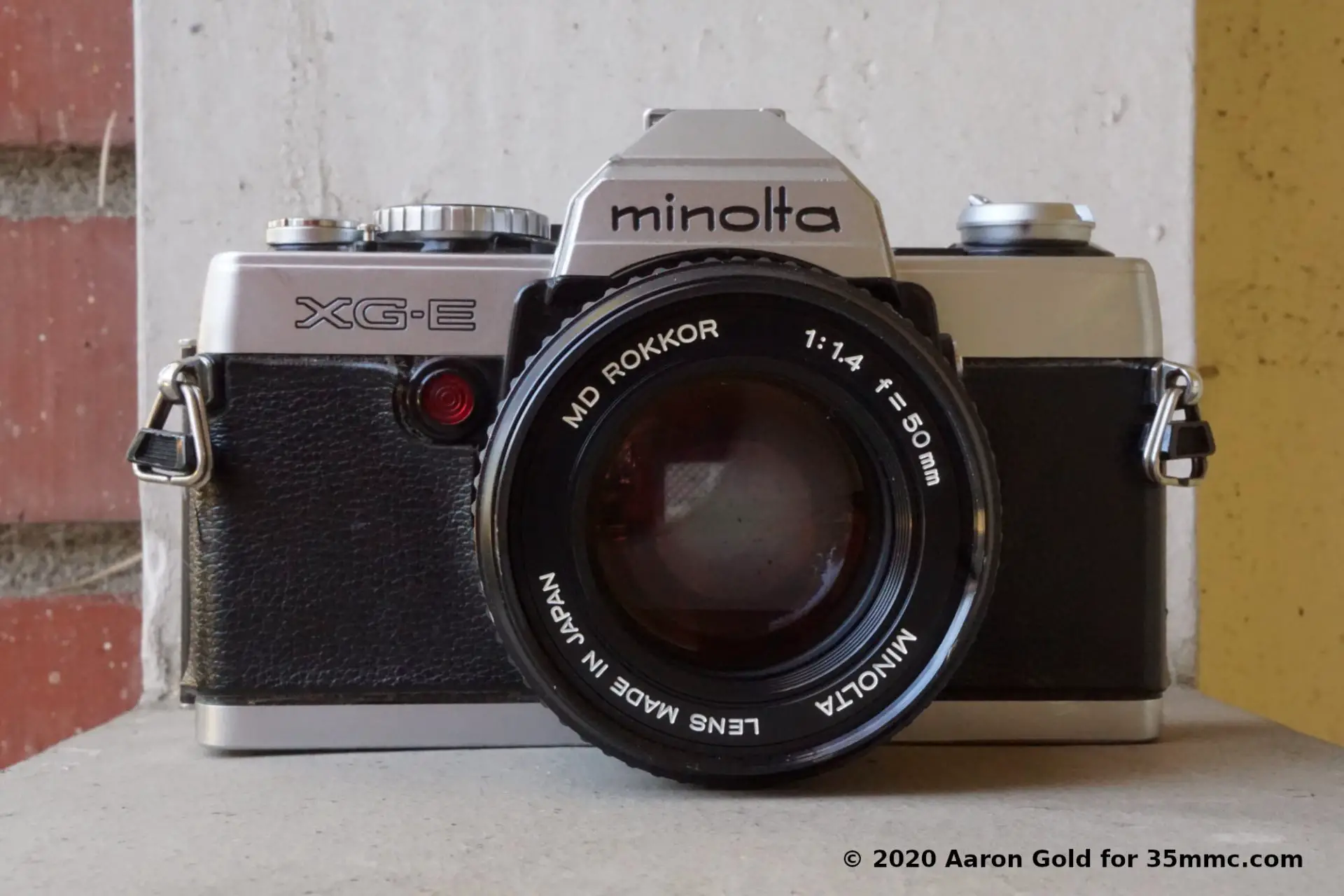








Comments
Terry B on Minolta XG-E Review: Takes a Lickin’ and Keeps On Tickin’ – by Aaron Gold
Comment posted: 15/05/2020
It's the lens that gives us the image, and lenses from the heyday of Minolta are all gems, and were highly rated. Quite why they don't seem to be so regarded today, I don't know, but this is good news for discerning photographers who can still (but for how much longer?) get good buys.
The "problem" with the lack of the meter not working in manual mode is, I suspect, down to cost and possibly the market Minolta envisaged for this pared down model. Back in the day, I recall cameras being marketed with full metering in manual mode as a plus point.
I acquired my XD-7 (XD-11 for you Yanks) around 1982 and it is indeed a wonderful camera. I find that the aperture priority auto setting better suited to my needs for two reasons - I have control over DoF, but also I can set the aperture to its optimum using f5.6 or f8, where DoF isn't of prime importance.
You've posted some wonderful images here. The one of your friend Jason is quite amusing if one zooms into his eyes which we see as almost popping with anticipation! FP4 was my standard medium speed film and so I am interested in what developer was used here as quite often on the 'net I see images shot on FP4 which haven't dont it justice. Yours do.
Sorry I can't send you $20, but I'm sure you'll appreciate that the £/$ isn't doing too well at present.
Comment posted: 15/05/2020
Rob on Minolta XG-E Review: Takes a Lickin’ and Keeps On Tickin’ – by Aaron Gold
Comment posted: 15/05/2020
The best bit of whatever XG series camera is that you still get access to incredible (and cheap) Minolta lenses and they will cost a fraction of what the largely similar X-700 (and again, the XG-M is essentially an X-700 without Program mode) will cost! Extra bonus point, you can then use the same lenses if you upgrade to an XD7/XD11 or SRT-series cameras.
Just don't go telling everybody how good Minolta cameras and lenses actually are...
Wim van Heugten on Minolta XG-E Review: Takes a Lickin’ and Keeps On Tickin’ – by Aaron Gold
Comment posted: 15/05/2020
Nice writing and nice pictures! I wonder why you keep saying the camera is beaten and fell out of a tree! From what I see in the four pictures it is a very well kept sample that needs the leatherette to be reglued. Or are back and bottom looking terrible?
Comment posted: 15/05/2020
Louis Sousa on Minolta XG-E Review: Takes a Lickin’ and Keeps On Tickin’ – by Aaron Gold
Comment posted: 15/05/2020
Comment posted: 15/05/2020
Mike on Minolta XG-E Review: Takes a Lickin’ and Keeps On Tickin’ – by Aaron Gold
Comment posted: 15/05/2020
Jim Grey on Minolta XG-E Review: Takes a Lickin’ and Keeps On Tickin’ – by Aaron Gold
Comment posted: 15/05/2020
Matthias on Minolta XG-E Review: Takes a Lickin’ and Keeps On Tickin’ – by Aaron Gold
Comment posted: 15/05/2020
beautiful shots. As all late 70ies Minolta cameras your XG-E meters and exposes very nice. Esp. the dog toy picture is awesome. And get yourself the XD-11, it's worth the money. I have a very beautiful XD-7 (as I'm in Europe) in almost mint condition. It's the greatest SLR I've ever used with a fantastic bright viewfinder (the one of the XG-E shouldn't be worse) and and an always-on lightmeter (and no battery-life-problem though) with no need for an on/off switch. Depth of field preview, same nice shutter-speed dial, exposure compensation, all you need in a camera and not more. And get some nice cheap Rokkor lenses, they are also worth it.
Regards Matthias
Andrew B on Minolta XG-E Review: Takes a Lickin’ and Keeps On Tickin’ – by Aaron Gold
Comment posted: 15/05/2020
You could always get some new camera leather (maybe a 70s-era pastel blue?) but maybe that would be too much, defeating its love-me-for-what-I-am vibe. I enjoyed your story.
Peter on Minolta XG-E Review: Takes a Lickin’ and Keeps On Tickin’ – by Aaron Gold
Comment posted: 15/05/2020
Thank you for another delightful, informative, and hilarious read!
"My uneducated guess is that the Minolta folks were trying to save money by sharing parts with the XD. All well and good, but I still can’t believe that a group of seemingly intelligent men (and they had to be men; it was the 1970s, and besides, no woman would suggest anything so asinine) got together in a conference room and convinced themselves this was a good idea. Only from the mind of Minolta, I guess."
That one earned a spit-take of Twinings Irish Breakfast! You brought back memories of a 7 year old telling his father to drop the Ricoh and get the Minolta because the TV said they're better.
Murray Kriner on Minolta XG-E Review: Takes a Lickin’ and Keeps On Tickin’ – by Aaron Gold
Comment posted: 15/05/2020
Comment posted: 15/05/2020
Sroyon on Minolta XG-E Review: Takes a Lickin’ and Keeps On Tickin’ – by Aaron Gold
Comment posted: 19/05/2020
Comment posted: 19/05/2020
spaq on Minolta XG-E Review: Takes a Lickin’ and Keeps On Tickin’ – by Aaron Gold
Comment posted: 19/05/2020
I do own an XG-1 with the 1.4/50, and I like it a lot too. I'm only missing DoF preview, the rest is absolutely fine. The meter being disabled in manual mode is silly, I agree, but I don't use it that often (the compensation dial does the job most of the time, if something unconventional is required). I do want to get the other Rokkors, mainly 2.8/135 and 3.5/28 (which is sharper than 2.8/28), but for now I use legacy M42 lenses with a simple adapter, and while they're not expensive lenses by any means, I don't see the need yet.
As for aperture priority... well, I think of manual as aperture priority with extra steps. I do use fully manual, meterless medium format cameras, and I usually think in terms of the aperture first anyway.
Jeff on Minolta XG-E Review: Takes a Lickin’ and Keeps On Tickin’ – by Aaron Gold
Comment posted: 31/05/2020
Howie Dewing on Minolta XG-E Review: Takes a Lickin’ and Keeps On Tickin’ – by Aaron Gold
Comment posted: 07/11/2020